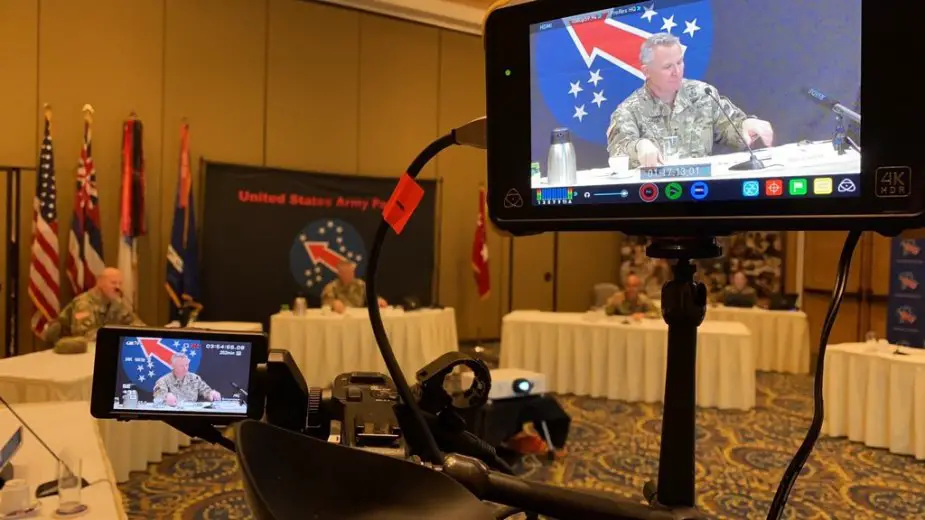Breaking news
New normal for Indo-Pacific partners may include larger virtual presence.
Virtual meetings between key leaders may be more frequent and create even closer partnerships after the pandemic, U.S. and foreign military officials across the Indo-Pacific region said during an online forum this week. Sean Kimmons, Army News Service, reports.
Follow Army Recognition on Google News at this link

U.S. Army Chief of Staff Gen. James C. McConville (top left) engages with other military leaders during an Indo-Pacific Landpower Conference, May 20, 2020. The virtual conference, held by U.S. Army Pacific, allowed U.S. and foreign military officials to discuss the way forward in a post-COVID-19 environment (Picture source: U.S. Army/screenshot)
The Indo-Pacific Landpower Conference 2020 -- held online by U.S. Army Pacific after the Association of the U.S. Army canceled its Land Forces Pacific Symposium in Hawaii -- allowed many of the same leaders to engage virtually from halfway around the world. “A lot has changed in a very short time,” Gen. James C. McConville, the Army’s chief of staff, told his online audience. “And I can imagine, in many ways … we’re not going to go back to the way things were before COVID-19.”
McConville said Wednesday the two-day conference was one example where the Army has turned to technology to continue its mission. Army recruiters, for instance, have recently embraced virtual recruiting to mine for prospects on social media sites. Installation commanders have held virtual town halls to ease concerns in their communities, and chaplains have provided online services so followers can stay home.
And when Soldiers need to work face-to-face, the Army has rolled out safety measures, such as mask requirements, physical distancing, screening and testing for the virus. “I have been very encouraged over the last few months by the incredible flexibility and ingenuity of our armed forces,” he said. “We’ve adapted all across the Army, putting new processes in place to ensure the health and safety of our people.”
The conference brought in some of Indo-Pacific’s top army leaders to discuss how their formations have dealt with the pandemic while ensuring a free and open strategy in the region. “It is a challenge that reinforces what we already know: working together as partners matters and sharing what we know makes a difference,” said Gen. Paul LaCamera, commander of USARPAC.

Gen. Paul LaCamera, commander of U.S. Army Pacific, engages with other military leaders during an Indo-Pacific Landpower Conference, May 20, 2020. The virtual conference, held by USARPAC, allowed U.S. and foreign military officials to discuss the way forward in a post-COVID-19 environment (Picture source: U.S. Army/screenshot)
After years of leading troops in past conflicts, LaCamera said there is no doubt the next fight will involve combined, joint and interagency efforts. “There’s an old proverb that is very evident today, which states: ‘If you want to go fast, go alone. If you want to go far, go together.’
“That’s what this landpower conference is about, and that’s why we’re here today. This network of allies and partners does business according to a rules-based international order that benefits all of us. We have relied on trust, built among our militaries, to navigate our way through this crisis and beyond.”
With partners stretched all over the U.S. Army’s largest theater of operations, some leaders suggested that more trust can be sown through virtual interactions.
Indian Army Lt. Gen. A Arun, director-general of perspective planning, mentioned they are also budget-friendly and can help governments cut on travel costs. “My view is that we must reenergize and exploit this inability to travel in these COVID times to enhance our interactions,” he said. “And it is our belief that these increased interactions will actually pave the way for further regional cooperation.” LaCamera agreed and gave two thumbs up to his counterpart through the video teleconference.
Marine Maj. Gen. Stephen Sklenka, director of strategic planning and policy at U.S. Indo-Pacific Command, said he was not sure how much good meeting a counterpart only once or twice a year in-person does for developing relationships.
“There is something to be said for the number of interactions,” Sklenka said. “When I pick up the phone or can go on a video teleconference to speak and meet with my counterpart on a pretty regular basis, I think that actually strengthens the partnerships. It strengthens friendships.”
While face-to-face encounters should still be valued, he said, militaries have also learned the value of technology while living in the current environment.
The U.S. military, though, has not yet taken full advantage of the virtual presence that is out there, said Air Force Maj. Gen. Robert Skinner, director of the command, control, communications and cyber for INDOPACOM. “I would say there is a new normal, and that new normal is a hybrid of what we used to have of where we may not be 90 percent in-person discussions. It may be more 50-50,” he said. “There are many tools and many capabilities available that we can leverage to the fullest to continue that presence,” he added, “and continue to ensure our allies and partners understand that we are in it together across the theater, whether it’s physical or virtual.”


























